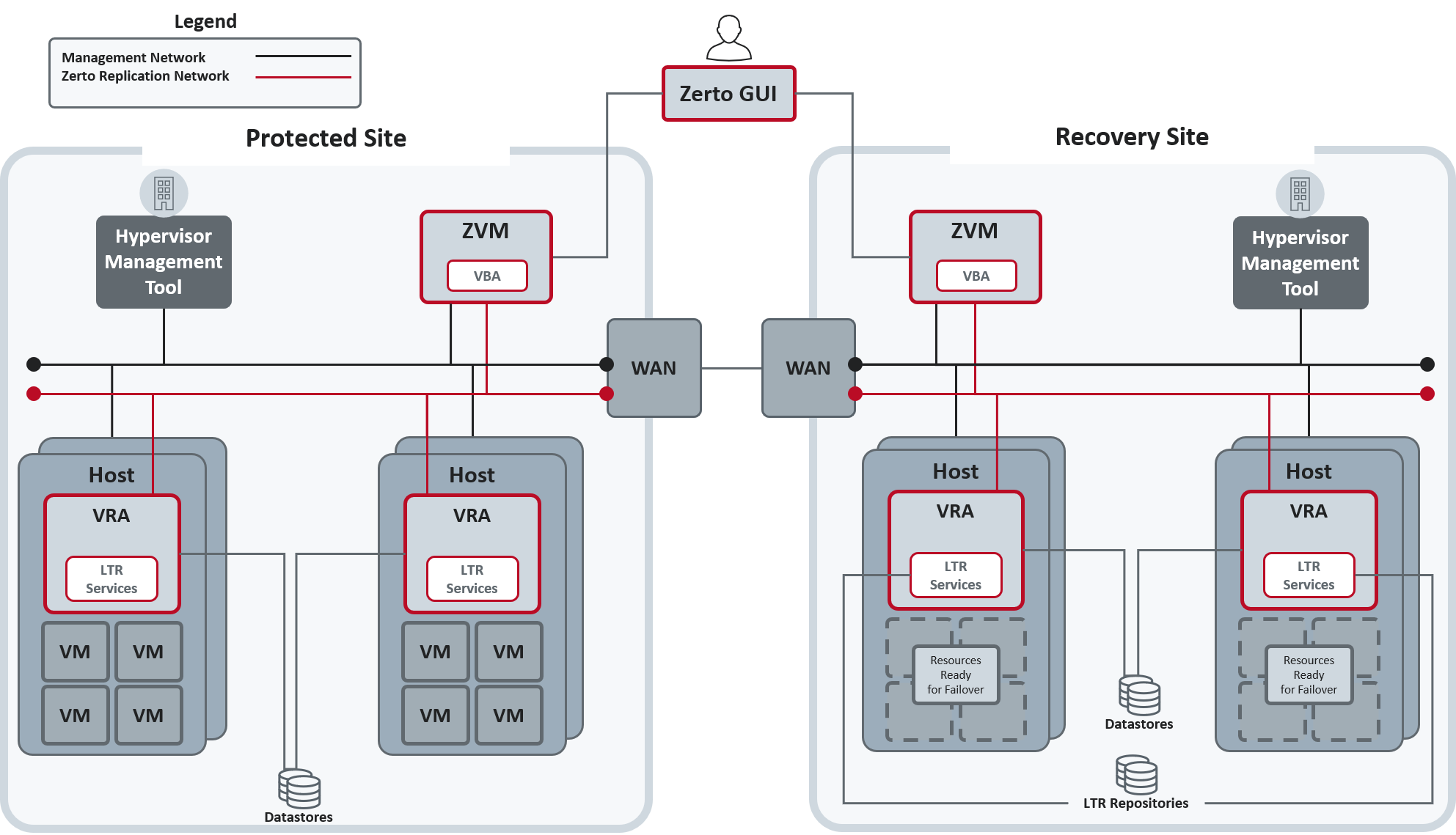The Zerto Solution Architecture
Zerto provides a business continuity (BC) and disaster recovery (DR) solution in a virtual environment, enabling the replication of mission-critical applications and data as quickly as possible, with minimal data loss. When devising a recovery plan, these two objectives, minimum time to recover and maximum data to recover, are assigned target values: the recovery time objective (RTO) and the recovery point objective (RPO). Zerto enables a virtual-aware recovery with low values for both the RTO and RPO. In addition, Zerto enables protecting virtual machines for extended, longer term recovery using a Long-term Retention process mechanism.
Zerto helps customers accelerate IT transformation by eliminating the risk and complexity of modernization and cloud adoption. By replacing multiple legacy solutions with a single IT Resilience PlatformTM, Zerto is changing the way disaster recovery, retention and cloud are managed. This is done by providing enterprise-class disaster recovery and business continuity software for virtualized infrastructure and cloud environments.
In on-premise environments, Zerto Virtual Replication (ZVR) is installed with virtual machines to be protected and recovered.
In public cloud environments, Zerto Cloud Appliance (ZCA) is installed in the public cloud site that is to be used for recovery.
The installation includes the following:
|
•
|
Zerto Virtual Manager (ZVM): The ZVM is a Windows service, running on a dedicated Windows VM, that manages everything required for the replication between the protection and recovery sites, except for the actual replication of data. The ZVM interacts with the hypervisor management user interface, such as vCenter Server or Microsoft SCVMM, to get the inventory of VMs, disks, networks, hosts, etc. It also monitors changes in the hypervisor environment and responds accordingly. For example, a VMware vMotion operation, or Microsoft Live Migration of a protected VM from one host to another is seen by the ZVM, and the Zerto User Interface is updated accordingly. |
|
•
|
Virtual Replication Appliance (VRA): A VRA is a virtual machine installed on each hypervisor host where VMs are to be protected from or to. The VRA manages the replication of data from protected virtual machines to the recovery site. The target VRAs are responsible for maintaining any protected VMs disks. VMware limits the number of SCSI Controllers (4 per VM) and targets per Controller (15 per controller), leaving a maximum of 60 SCSI targets per VM. When managing a larger quantity of virtual disks, Zerto utilizes Virtual Replication Appliance Helpers (VRA-H), which act as a disk box with no IP and nearly no resources. VRA-Hs are spun up and down by Zerto automatically when nearing the 60-disk limit of the VRA or last VRA-H. |
|
•
|
Virtual Backup Appliance (VBA): A Windows service that manages File-Level Recovery operations within the Zerto solution. |
|
•
|
Zerto User Interface: Recovery using the Zerto solution is managed in a browser or, in VMware vSphere Web Client or Client console. |
When Zerto is installed to work with an on-premise hypervisor it also comprises the following component:
|
•
|
Data Streaming Service (DSS): Installed on the VRA machine, and runs in the same process as the VRA. It is responsible for all the retention data path operations. |
The following diagram shows how the main Zerto components are deployed across hypervisor-based enterprise sites to provide disaster recovery across these sites.

When you plan to recover the enterprise site to a public cloud, ZCA is installed in the cloud environment. ZCA comprises the same components but the VRA runs as a service, so that the ZVM, VRA, and VBA all run as services on a single virtual machine instance in the public cloud.
See also:
